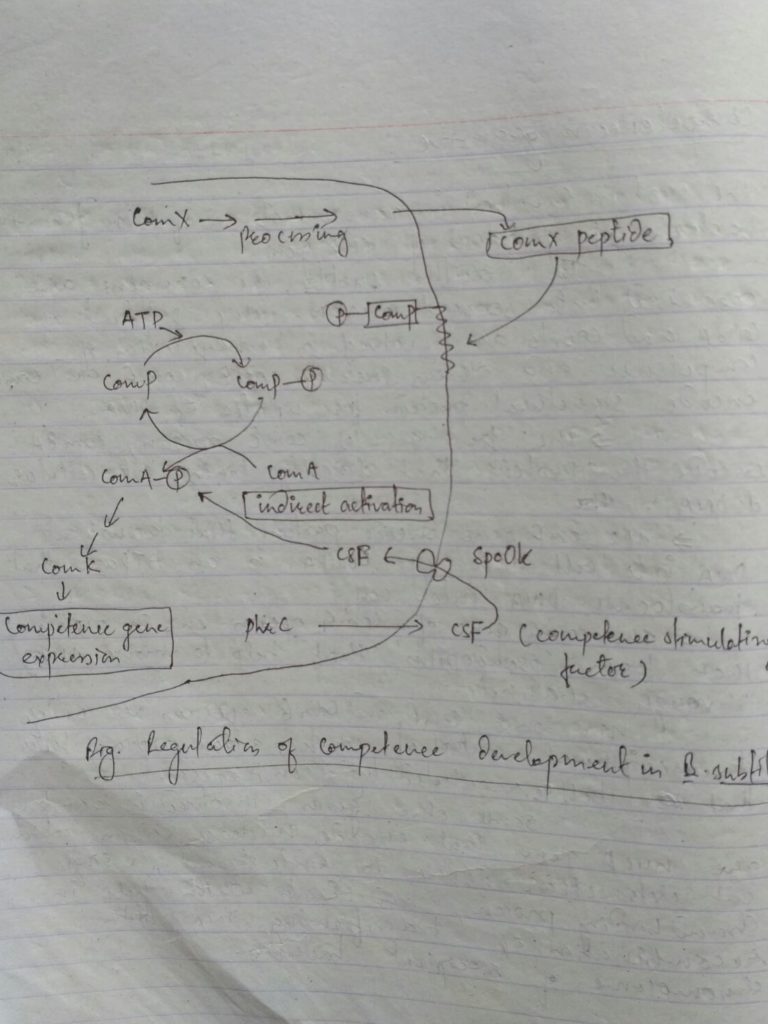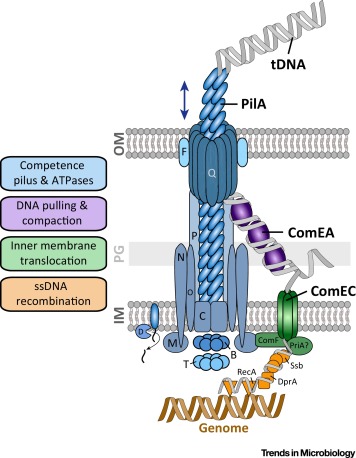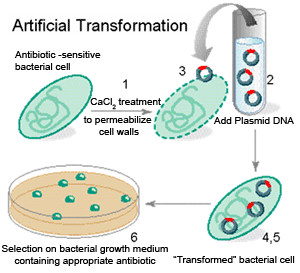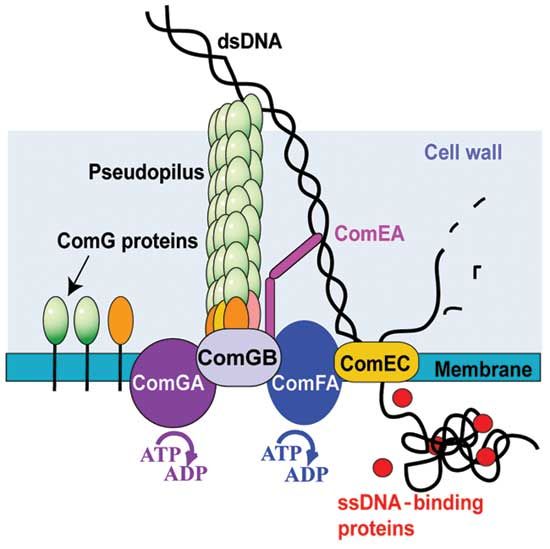
Transformation in Bacteria
- Transformation is the process of introduction of derived DNA fragments from a donor bacteria into a recipient bacteria.
- It is one of the cornerstone of molecular genetics.
- It is the transfer of naked DNA from donor cell to recipient cell.
Types of transformation
- Natural transformation
- Artificial transformation
Natural transformation:
- Most types of cell cannot take up DNA efficiently unless they have been exposed to special chemical or electrical treatment to make them more permeable.
- However, some types of bacteria are naturally transformable ie they can take DNA from environment without requiring special treatment.
- Bacteria that take up DNA are called competent.
- At least 40 species of naturally competent and transformable bacteria have been found.
Gram +ve : Bacillus subtilis, Streptococcus pneumonae
Gram –ve: Haemphilus influenzae, Neisseria gonorrahe, Helicobacetr pylori, Acenetobacter baylyi, Cyanobacteria
Competence in Gram positive bacteria: Mechanism of uptake DNA during transformation
Figure: competence in Bacillus subtilis
- The protein involved in transformation of these Gram +ve bacteria is a product of com
- In Bacillus subtilis , the com gene are organized into several operons.
- The product of com A and com K are involved in regulation of competence and other com E, com F and com G encodes structural protein for uptake of DNA.
- The first gene of com E operon, com EA encodes the protein that directly binds extracellulat double stranded DNA.
- The com F gene encodes the protein that translocate DNA into cell. for example; Com FA is an ATPase that translocate DNA into cell.
- The com G gene of comG operon encodes protein that form pseudopilus that helps to move DNA through channel.
- The com E, com F and com G operon are under transcriptional control of com K operon.
- Com K is a transcriptional factor that is regulated by com A
- Some other genes involved in transformation are nuc A gene that encodes nuclease enzyme which cuts extracellular dsDNA to single stranded,
- Single strand binding protein and Rec A gene which helps in recombination of transforming DNA with chromosome of recipient bacteria.

Competence in Gram negative bacteria: mechanims of uptake of DNA during transformation
- A variety of Gran Negative bacteria are capable of competence.
- Some examples are Acenetobacter calcoaceticus, Helicobacter pylori, Neisseria spp, etc
- H. pylori and Neisseria spp require specific DNA sequences for binding of DNA so these species take up DNA from same species only.
Gram-ve bacteria utilizes two different pathway for uptake of DNA
- PSTC transformation pathway
- Type IV secretion related pathway
PSTC transformation pathway

Figure: Competence in Gram negative bacteria by PSTC pathway
- The term PSTC has been applied to some protein indicating their multiple role in Pilus formation, Secretion, Twitching motility and Competence.
- These proteins form structure needed to transport DNA across the cell wall and cell membrane.
- Many of these proteins that function in DNA uptake in H. influenza, Neisseria, Acinetobacter, Vibrio etc are related to com G
Type IV secretion related pathway
- This mechanism is found in Helicobacter pylori.
- The DNA is translocated through cell wall and membrane with the help of protein similar to Agrobacterium for conjugation of Ti plasmid.
- Type IV system function transfer of DNA in two ways-moving in and out of cell.
Artificial transformation

figure: artificial transformation
Most of the bacteria are not natural transformable. These bacteria can be made competence by certain chemical treatment or by strong electrical shock.
Some of the methods are-
Calcium treatment:
- Treatment with calcium ion (ca++) make same bacteria eg. E.coli, Salmonella, Pseudomonas etc competence.
- The Calcium ion increases the permeability of cell membrane
- Cell treated with calcium can take up both ssDNA as well as dsDNA, no matter circular or linear.
Electroporation:
- A strong electric shock is applied in the bacterial culture mixed with naked DNA
- The recipient bacteria should be wash with non-ionic (distilled water) solution to prevent osmotic shock.
- The strong electric field creates artificial pore of water lined by phospholipid head group. The DNA can pass through these artificial hydrophilic pore.
References
- http://ars.els-cdn.com/content/image/1-s2.0-S0966842X15002474-gr1.jpg
- http://2014.igem.org/wiki/images/e/e8/B._subtilis_dna_uptak.jpg
- https://www.ncbi.nlm.nih.gov/pmc/articles/PMC372826/
- https://en.wikipedia.org/wiki/Transformation_(genetics)
- https://www.khanacademy.org/science/biology/biotech-dna-technology/dna-cloning-tutorial/a/bacterial-transformation-selection
- https://www.boundless.com/microbiology/textbooks/boundless-microbiology-textbook/microbial-genetics-7/genetic-transfer-in-prokaryotes-81/bacterial-transformation-442-6842/
- https://www.sciencelearn.org.nz/resources/2032-bacterial-transformation
- https://www.ncbi.nlm.nih.gov/books/NBK21993/
- https://www.nature.com/subjects/bacterial-transformation
- http://jb.asm.org/content/196/8/1471.full.pdf
- https://www.jove.com/science-education/5059/bacterial-transformation-the-heat-shock-method
- https://www.thermofisher.com/np/en/home/life-science/cloning/cloning-learning-center/invitrogen-school-of-molecular-biology/molecular-cloning/transformation/bacterial-transformation-workflow.html
- http://microbeonline.com/bacterial-transformation-mechanism/
- http://study.com/academy/lesson/bacterial-transformation-definition-steps-analysis.html

